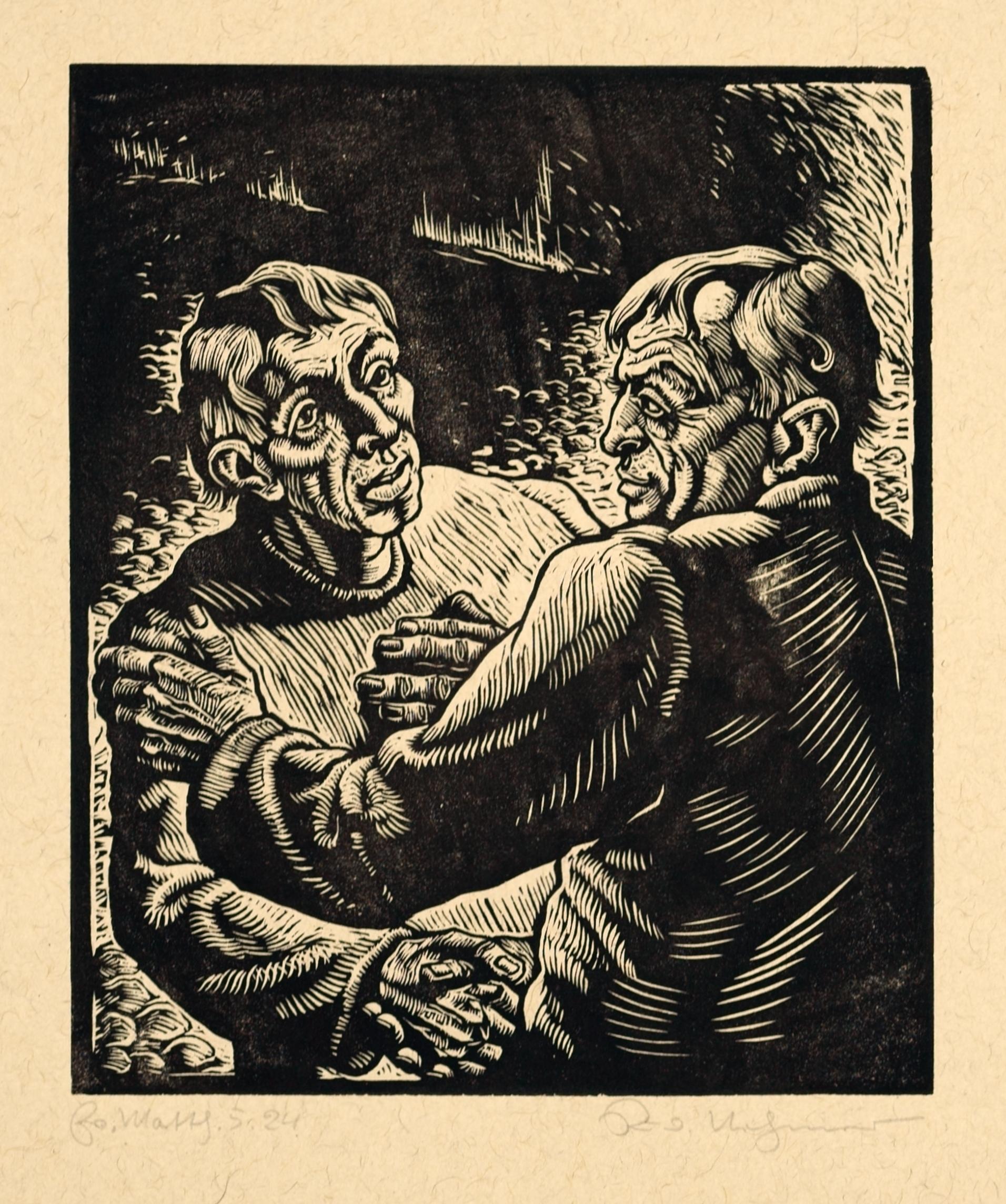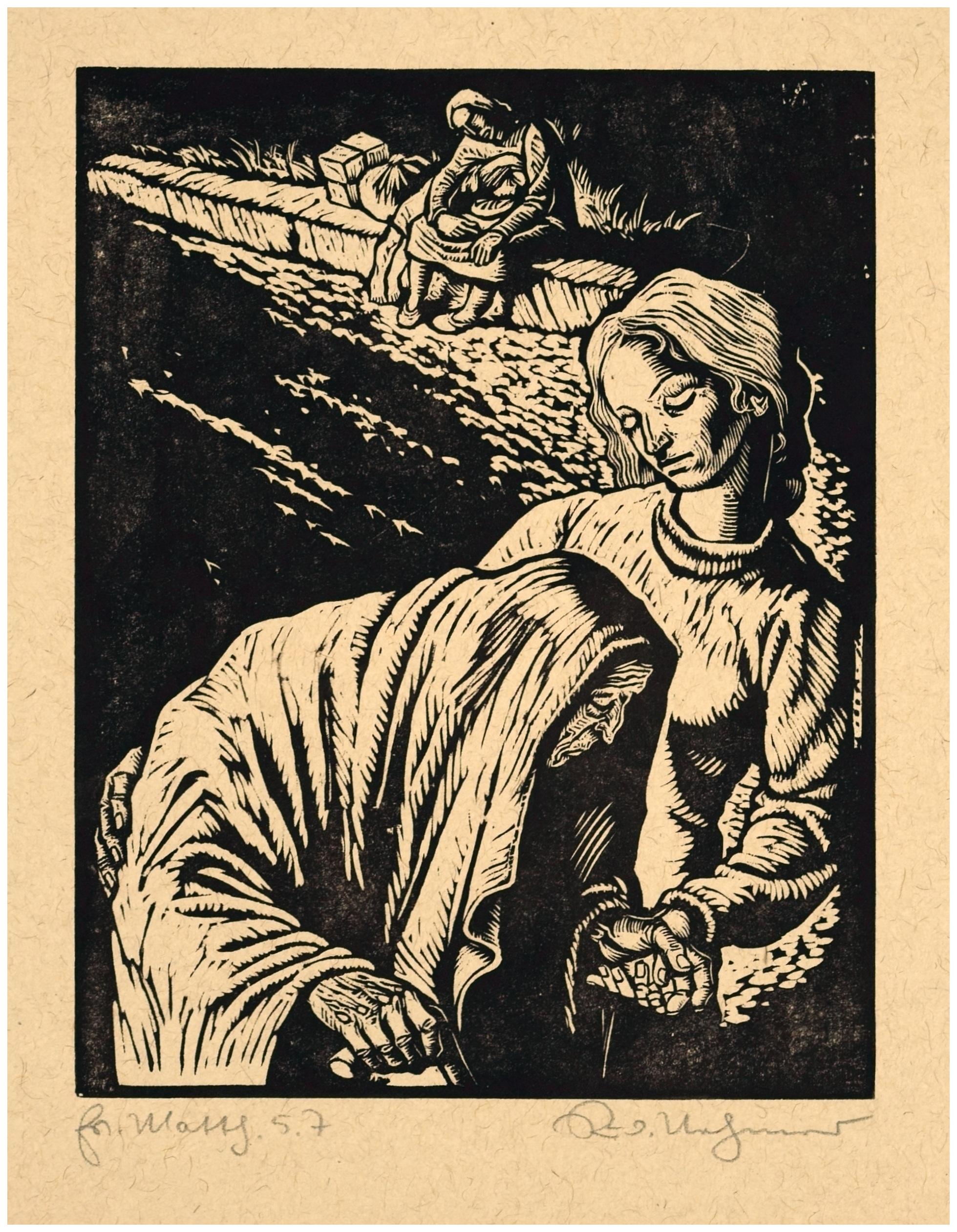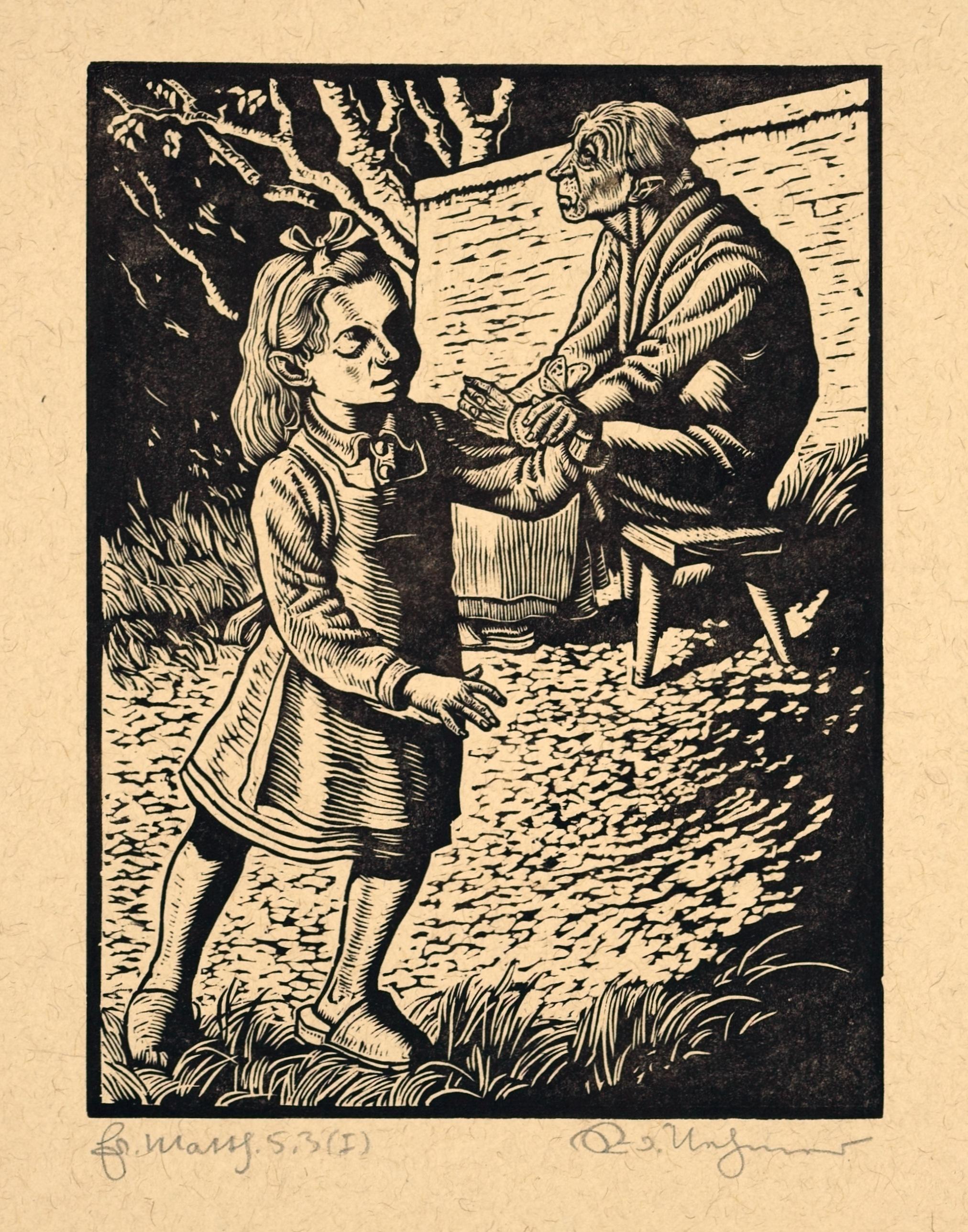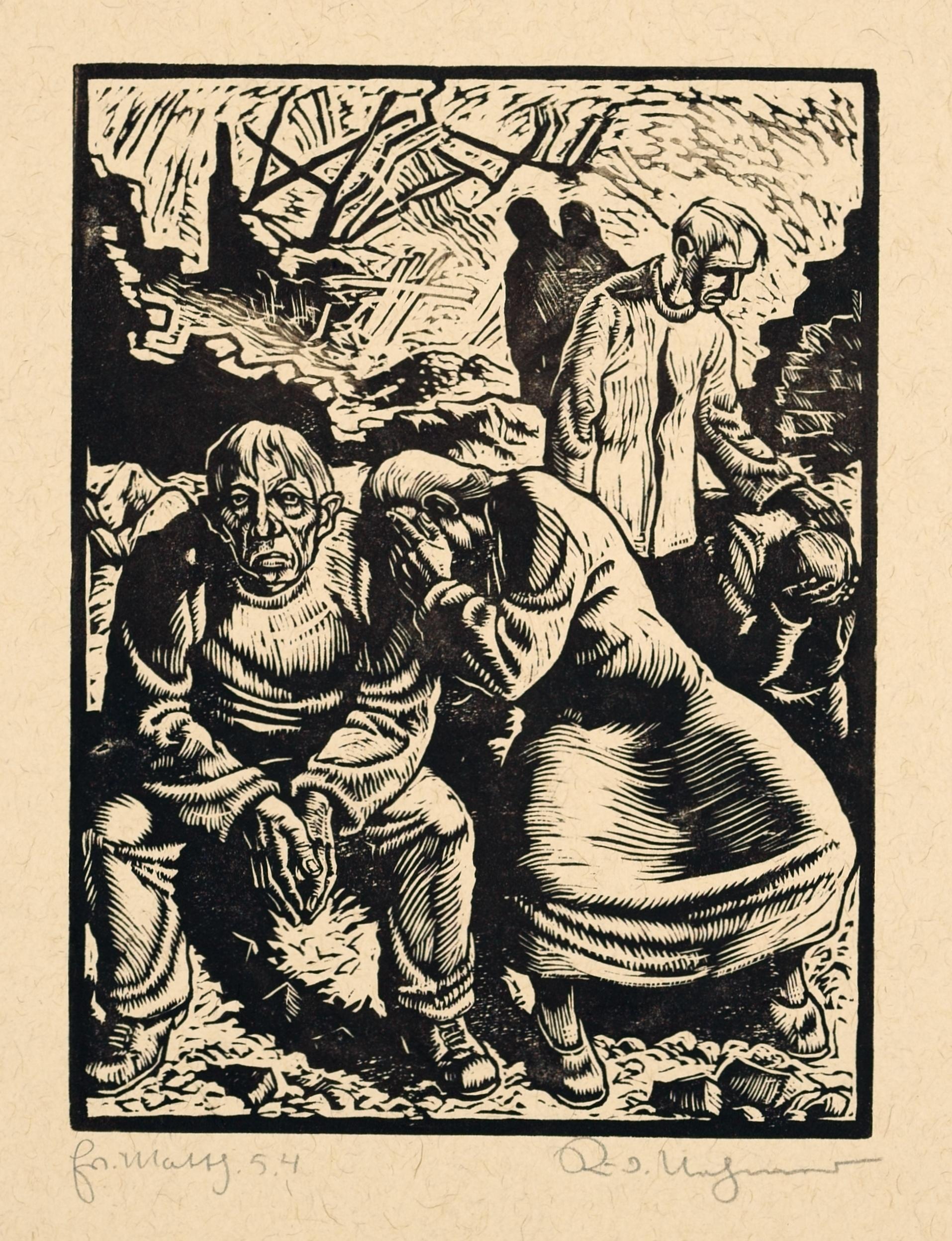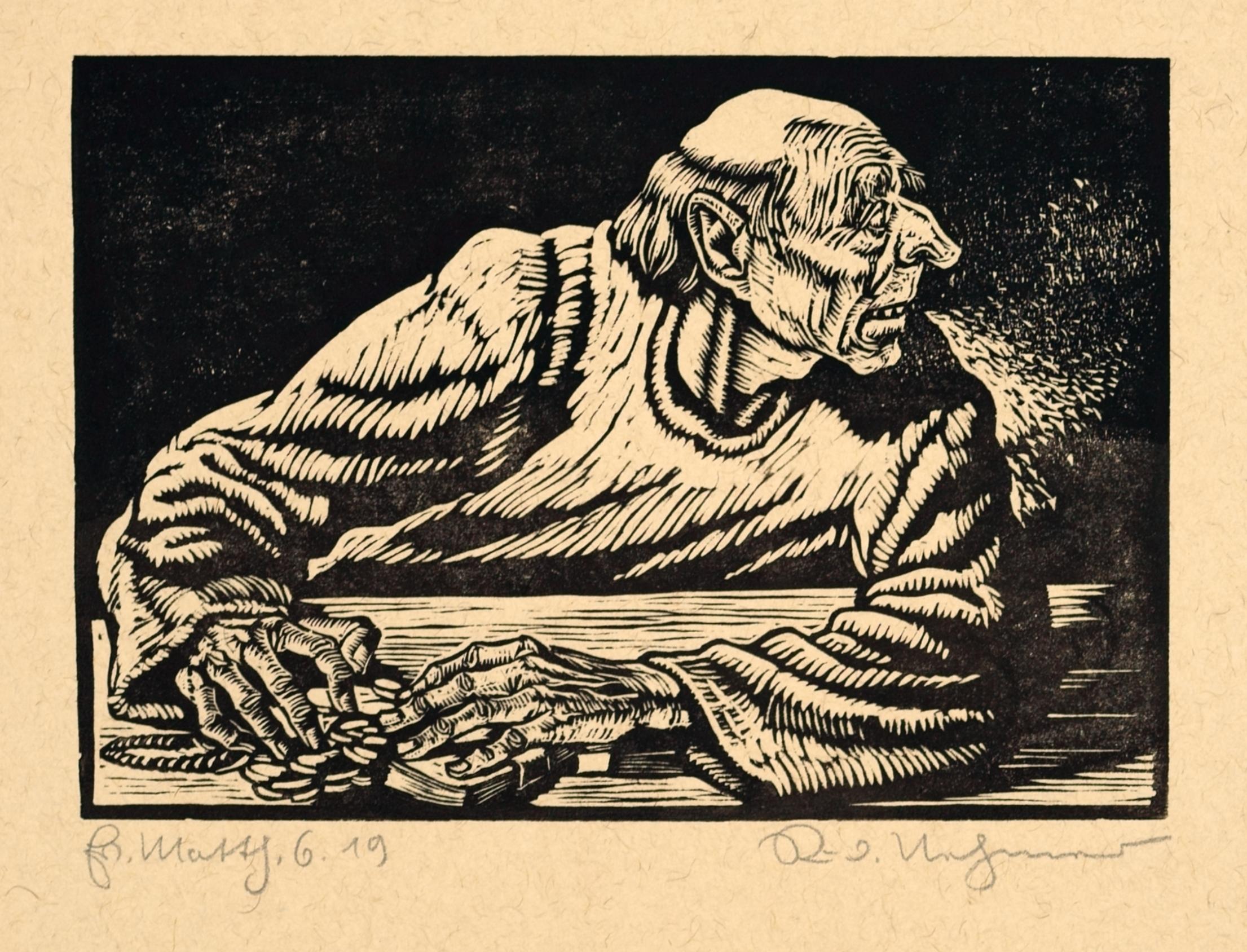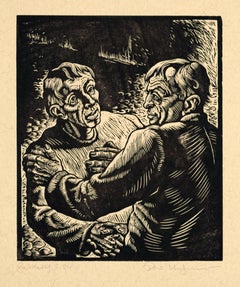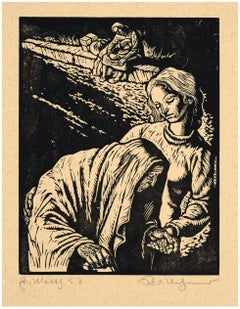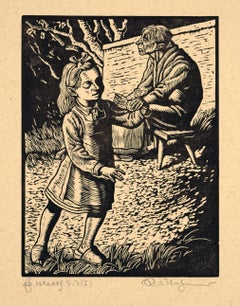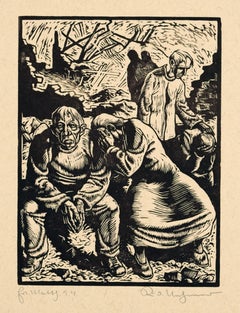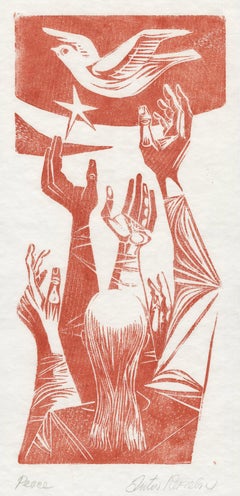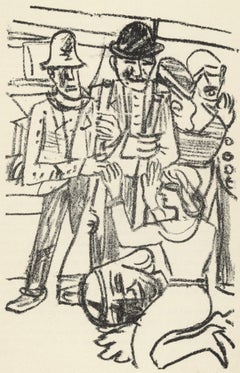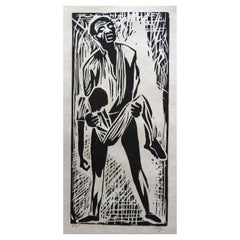Items Similar to Blessed are the peacemakers / - Dehumanization -
Want more images or videos?
Request additional images or videos from the seller
1 of 8
Rudolf NehmerBlessed are the peacemakers / - Dehumanization -1948
1948
$170.15
$212.6920% Off
£129.49
£161.8620% Off
€144
€18020% Off
CA$238.18
CA$297.7320% Off
A$262.46
A$328.0720% Off
CHF 136.13
CHF 170.1720% Off
MX$3,121.60
MX$3,902.0120% Off
NOK 1,722.05
NOK 2,152.5620% Off
SEK 1,613.20
SEK 2,016.4920% Off
DKK 1,096.97
DKK 1,371.2220% Off
About the Item
Rudolf Nehmer (1912 Bobersberg - 1983 Dresden), Blessed are the peacemakers, 1948. Woodcut on yellowish wove paper, 18 cm x 15.5 cm (image), 45 cm x 30 cm (sheet size), signed “Rud.[olf] Nehmer” in pencil lower right and inscribed “Matth. 5,9” lower left.
- The wide sheet margin somewhat wavy in places, the image in excellent, vibrant condition.
- Dehumanization -
This woodcut is part of Nehmer's most famous series, his pictorial interpretation of the Sermon on the Mount (Matth. 5,1-7,29), created shortly after the end of World War II. The print illustrates the beatitude: Blessed are the peacemakers, for they shall be called children of God (Mt 5:9).
The two opponents are disfigured in their humanity by the fight. The smaller man's head is unrecognizable except for his disheveled hair, while the larger man's mouth is covered and his physiognomy distorted. Another man approaches the brawlers and stops them with a gentle yet firm gesture, raising the question of whether such behavior is worthy of God's creatures.
About the artist
Rudolf Nehmer studied from 1932 to 1934 in Dresden at the private art academy founded by Ernst Oskar Simonson-Castelli under Woldemar Winkler and, after a brief interlude at the art academy, was a student in Willy Kriegel's studio until 1936. After his first one-man show in 1935 at the Kühl Art Exhibition in Dresden, which was progressive until the Nazi era, Nehmer was represented at the major German art exhibitions in the following years. In 1938 he stayed in Worpswede. From 1941 he was a soldier on the Western Front and in Denmark, returning to Dresden from British captivity in 1945. After the war, he had his first solo exhibition in 1945. Nehmer was a co-founder of the artists' association 'Das Ufer - Gruppe 1947' and in 1951 a founding member of the artists' cooperative 'Kunst und Zeit'. He had numerous solo and group exhibitions in the GDR, culminating in a retrospective at the Galerie Neuer Meister on the occasion of his 60th birthday.
GERMAN VERSION
Rudolf Nehmer (1912 Bobersberg - 1983 Dresden), Selig sind die Friedfertigen, 1948. Holzschnitt auf gelblichem Velin, 18 cm x 15,5 cm (Darstellung), 45 cm x 30 cm (Blattgröße), unten rechts in Blei mit „Rud.[olf] Nehmer“ signiert und unten links mit „Matth. 5,9“ bezeichnet.
- Der breite Blattrand teilweise etwas gewellt, die Darstellung in ausgezeichnetem farbkräftigem Zustand.
- Entmenschlichung -
Der Holzschnitt gehört zu Nehmers bekanntester Graphikfolge, seiner kurz nach dem Ende des Zweiten Weltkrieges geschaffenen bildlichen Auslegung der Bergpredigt (Matth. 5,1-7,29). Das Blatt veranschaulicht die Seligpreisung: Selig sind die Friedfertigen; denn sie werden Gottes Kinder heißen (Matth. 5,9).
Die beiden Kontrahenten sind durch die Rauferei in ihrer Menschlichkeit entstellt. Der Kopf des Kleineren ist, bist auf die zerzausten Haare, nicht zu erkennen, während dem Größeren der Mund zugehalten und die Physiognomie verschoben wird. Auf die Streithähne tritt ein weiterer Mann zu, der ihnen mit sanfter und doch bestimmender Geste Einhalt gebietet und die Frage aufwirft, ob ein derartiges Verhalten dem Geschöpf Gottes würdig sei.
zum Künstler
Rudolf Nehmer studierte von 1932 bis 1934 in Dresden an der von Ernst Oskar Simonson-Castelli gegründeten privaten Kunstakademie bei Woldemar Winkler und war – nach einem kurzen Intermezzo an der Kunstakademie – bis 1936 Schüler im Atelier von Willy Kriegel. Nach einer ersten Einzelausstellung im Jahre 1935 in der bis in die NS-Zeit hinein progressiven Dresdner Kunstausstellung Kühl, war Nehmer in den Folgejahren in den Großen Deutschen Kunstausstellungen vertreten. 1938 weilte er in Worpswede. Ab 1941 war er Soldat an der Westfront und in Dänemark und kehrte 1945 aus britischer Kriegsgefangenschaft nach Dresden zurück. Nach dem Kriegsende erfolgte bereits 1945 die erste Einzelausstellung. Nehmer war Mitbegründer der Künstlervereinigung ‚Das Ufer – Gruppe 1947‘ und war 1951 Gründungsmitglied der Künstlergenossenschaft ‚Kunst und Zeit‘. In der DDR erfolgten zahlreiche Einzelausstellungen und Ausstellungsbeteiligungen, die in einer Retrospektive anlässlich seines 60. Geburtstags in der Galerie Neuer Meister gipfelte.
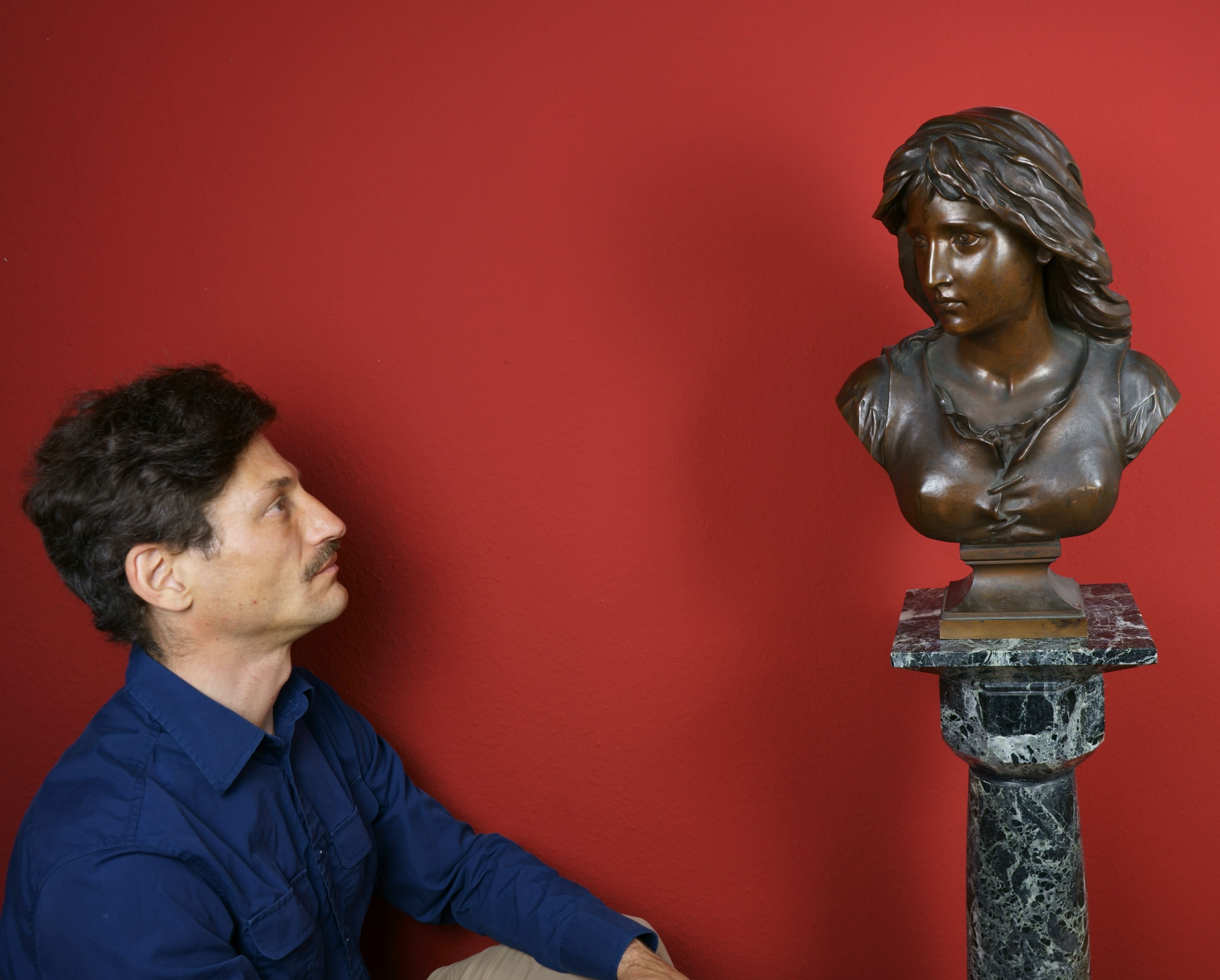
About the Seller
5.0
Vetted Professional Seller
Every seller passes strict standards for authenticity and reliability
Established in 2014
1stDibs seller since 2023
22 sales on 1stDibs
- ShippingRetrieving quote...Shipping from: Berlin, Germany
- Return Policy
More From This Seller
View AllThe Reconciliation / - Togetherness -
Located in Berlin, DE
Rudolf Nehmer (1912 Bobersberg - 1983 Dresden), The Reconciliation, 1948. Woodcut on yellowish wove paper, 20 cm x 15 cm (image), 45 cm x 30 cm (sheet size), signed “Rud.[olf] Nehmer...
Category
1940s Realist Figurative Prints
Materials
Woodcut
$170 Sale Price
20% Off
Blessed are the merciful / - The support of care -
Located in Berlin, DE
Nehmer, Rudolf (1912-1983), Blessed are the merciful, 1948
Rudolf Nehmer (1912 Bobersberg - 1983 Dresden), Blessed are the merciful, 1948. Woodcut on yellowish wove paper, 18.8 cm x ...
Category
1940s Realist Figurative Prints
Materials
Woodcut
$179 Sale Price
20% Off
Blessed are the spiritually poor / - The Abundance of Poverty -
Located in Berlin, DE
Rudolf Nehmer (1912 Bobersberg - 1983 Dresden), Blessed are the spiritually poor, 1948. Woodcut on yellowish wove paper, 20 cm x 15 cm (image), 45 cm x 30 cm (sheet size), signed “Ru...
Category
1940s Realist Figurative Prints
Materials
Woodcut
$179 Sale Price
20% Off
The Zero Hour / - After the End of the World -
Located in Berlin, DE
Rudolf Nehmer (1912 Bobersberg - 1983 Dresden), The Zero Hour, 1948. Woodcut on yellowish wove paper, 20 cm x 14.8 cm (image), 43 cm x 30 cm (sheet size), signed “Rud.[olf] Nehmer” i...
Category
1940s Realist Figurative Prints
Materials
Woodcut
$264 Sale Price
20% Off
Greed / - The Poverty of Wealth -
Located in Berlin, DE
Rudolf Nehmer (1912 Bobersberg - 1983 Dresden), The birds under the sky, 1948. Woodcut on yellowish wove paper, 11 cm x 18 cm (depiction), 43 cm x 30 cm (sheet size), signed “Rud.[ol...
Category
1940s Realist Figurative Prints
Materials
Woodcut
$170 Sale Price
20% Off
The fruitless tree / - The End of the Grotesque Era -
Located in Berlin, DE
Rudolf Nehmer (1912 Bobersberg - 1983 Dresden), The fruitless tree, 1948. Woodcut on yellowish wove paper, 15 cm x 14.6 cm (image), 45 cm x 30 cm (sheet size), signed “Rud.[olf] Nehm...
Category
1940s Realist Figurative Prints
Materials
Woodcut
$170 Sale Price
20% Off
You May Also Like
Isaac Friedlander, My People
By Isaac Friedlander
Located in New York, NY
Isaac (sometimes Isac) Friedlander's large wood engraving, My People, 1944, reflects his genuine social interest. After a youth of extreme hardship, including incarceration in a czar...
Category
1940s Expressionist Figurative Prints
Materials
Woodcut
Peace
By Anton Refregier
Located in Fairlawn, OH
Peace
Woodcut printed in orange red ink on japanese paper
Signed and titled in pencil lower right (see photo)
Titled lower left (see photo)
Created along with an illustrated book project Song of Peace, 1950-1959.
Condition: Excellent
Image: 10 1/2 x 4 7/8"
Sheet: 16 1/8 x 7";
Anton Refregier (March 20, 1905 – October 10, 1979) was a painter and muralist active in Works Progress Administration Federal Art Project commissions, and in teaching art. He was a Russian immigrant to the United States.
Among his best-known works is his mural series The History of San Francisco, located in the Rincon Center in downtown San Francisco, California. It depicts the city's history across twenty seven panels that he painted from 1940 to 1948.
Life and early career
Refregier was born in Moscow and emigrated to the United States in 1920. After working various odd jobs in New York City, he earned a scholarship to the Rhode Island School of Design in 1921. After finishing school, Refregier moved back to New York in 1925. To earn a living, Refregier worked for interior decorators, creating replicas of François Boucher and Jean-Honoré Fragonard paintings...
Category
1950s American Modern Figurative Prints
Materials
Woodcut
Beckmann, Composition (Hofmaier 323-329), Der Mensch ist kein Haustier (after)
By Max Beckmann
Located in Southampton, NY
Lithograph on Van Gelder Zonen Bütten paper. Inscription: Unsigned and unnumbered, as issued. Good condition. Notes: From the volume, Der Mensch ist kein Haustier, 1937. Published by...
Category
1930s Modern Figurative Prints
Materials
Lithograph
$1,036 Sale Price
58% Off
Free Shipping
Herman Volz Original Woodcut, Social Unrest of the 1960's, Social Unrest
By Herman Roderick Volz 1
Located in Phoenix, AZ
An original woodcut print depicting the social unrest of the 1960s by Herman Roderick Volz.
Pencil signed by the artist lower right. Image measures 24 1/2" x 11," sheet measures 29"...
Category
Mid-20th Century Figurative Prints
Materials
Paper
original woodcut
Located in Henderson, NV
Medium: original woodcut. This impression on wove paper was printed in 1919 for Das Kestnerbuch, an important collection of original prints published during the height of the German ...
Category
1910s Expressionist Prints and Multiples
Materials
Woodcut
Transfer of Injured - Original Lithograph by Pietro Morando - 1950s
By Pietro Morando
Located in Roma, IT
Transfer of injured is an artwork realized by Italian artist Pietro Morando (Alessandria 1889- 1980).
Lithograph print.
Hand-signed on the lower right in pencil, titled, referring to the war" 1915-1918"
Numbered on the lower left, the edition of 9/75 prints.
Very good condition.
The artwork represents an impressive and tragic scenery of suffering injured men, carrying by their fellows through deft strokes, the drawing of the figure has an authentic style of Morando inspired by his tragic experiences of war. Pietro Morando (Alessandria 1889- 1980). He occasionally studies at the Albertina Academy in Turin; a scholarship (1913) allows him to enroll in painting courses at the Brera Academy of Fine Arts in Milan. He meets Angelo Morbelli whose studio he frequents and temporarily shares the passion for pointillism. His love for drawing led him to produce numerous works, even using the poor means of luck that the First World War allowed him. He thus realizes tragic war drawings...
Category
Mid-20th Century Modern Figurative Prints
Materials
Lithograph
More Ways To Browse
Brian Clarke
Bruno Schulz
Caroline Durieux On Sale
Chagall Arabian Nights
Chagall In The Land Of Gods
Chagall Maternity
Chagall Paysage
Chagall Romeo
Chagall Ruth Gleaning
Chagall Signed Poster
Christ And The Rembrandt
Christian Silvain
Clemens Briels On Sale
Collier Picasso
Corneille Bleu
Cristina Martinez
Dali Alice In Wonderland
Dali Aliyah
